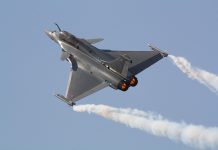
Captured by Russian forces in Ukraine, an M1A1 Abrams tank—manufactured by the U.S. and supplied to Ukraine—has recently been transported to Russia’s Uralvagonzavod for reverse engineering. The transfer, initially reported by the Russian Telegram channel “Military Observer,” details the tank’s arrival in Nizhny Tagil, where specialists at Uralvagonzavod, a prominent Russian armored vehicle producer, will conduct a thorough inspection. In the accompanying footage, the tank is obscured by a tarp, with only part of its main gun visible.
While the tank’s exact condition is unclear, it is speculated to be one of the best-preserved or least damaged American tanks captured in combat, making it an ideal candidate for reverse engineering. Of the 31 Abrams tanks sent to Ukraine, more than half have already been destroyed by Russian forces, though the specific tank in question remains unidentified. It is possible that this is the M1A1 captured near Donetsk in late October, as indicated by an image circulating at the time, showing a Russian soldier standing next to an Abrams tank in seemingly excellent condition.
Reverse engineering, a standard procedure in modern warfare, is not unique to one side. In fact, only a month and a half ago, a German Leopard 2A6 tank was similarly transported to Uralvagonzavod for study. Ukraine, too, has been reverse-engineering Russian missiles and weapon systems captured during combat. Through these efforts, Ukraine, aided by Western experts, has uncovered critical insights into Russian cruise missile technology.
The primary goal of reverse-engineering the M1A1 Abrams is to analyze its advanced features, providing Russian engineers with a deeper understanding of the systems that make the Abrams one of the most formidable tanks in the world. One of the key focuses will likely be the tank’s composite armor. The M1A1’s multi-layered armor, combining metals and ceramics, offers superior protection. Studying this technology could enable Russia to enhance its own tank armor and develop better countermeasures against anti-tank weapons.
The M1A1’s fire control system, which includes thermal imaging, laser rangefinders, and ballistic computers, ensures exceptional accuracy even under challenging conditions. By reverse-engineering these systems, Russia could improve its own tank targeting capabilities, thus boosting the effectiveness of its firepower.
Another critical area is the M1A1’s mobility. Powered by a gas turbine engine, the tank offers remarkable speed and agility, even in difficult terrain. Understanding the design and operation of this engine could allow Russian engineers to enhance the mobility of their own armored vehicles. Additionally, the M1A1’s advanced communication, navigation, and battlefield management systems are integrated into a network, enabling seamless coordination among different units. By studying these technologies, Russia could improve its own military communication and coordination.
The tank’s performance in real-world combat will also provide valuable lessons. Russian forces are likely to examine the M1A1’s durability in extended operations, identifying any vulnerabilities that could inform future Russian tank designs.
Through reverse engineering, Russia seeks to gain a technological edge, potentially reshaping its armored vehicle designs and strategies in the future of tank warfare.
The M1A1 Abrams, a highly advanced armored vehicle designed by the U.S., is equipped with composite armor, including a mix of ceramics, metals, and depleted uranium, offering superior protection against modern anti-tank threats. Its powerful armament, a 120mm smoothbore cannon, can fire a variety of rounds, including armor-piercing and high-explosive projectiles. The tank’s fire control system, equipped with thermal imaging, laser rangefinders, and a ballistic computer, ensures precise targeting even under challenging conditions.
The M1A1 is powered by a Honeywell AGT1500 gas turbine engine, producing over 1,500 horsepower, allowing it to reach speeds of up to 42 miles per hour. This mobility is further enhanced by a sophisticated suspension system, providing the tank with excellent performance across rough terrain. The M1A1’s tracks offer superior traction, making it highly effective in both urban and rural combat scenarios.
Inside, the tank’s crew of four operates in an environment designed for efficiency and protection, with advanced communication and targeting systems enabling rapid coordination. The tank is also equipped with battlefield management systems, enhancing its integration into combined arms operations. For Ukraine, the delivery of the M1A1 Abrams significantly strengthens its armored capabilities, making it a formidable asset in its ongoing conflict with Russian forces.




